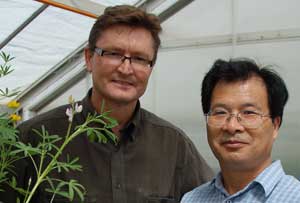Western Australia
April 29, 2009
 |
|
In
UWA’s glasshouse working on the GRDC supported hybrid
lupin project are (L to R) Project Leader Dr Jon
Clements of UWA and Dr Hua'an Yang of DAFWA |
A dainty pink flower with a tinge
of yellow is one characteristic of a hybrid plant representing a
genetic pathway to transfer best plant characteristics between
narrow-leafed and yellow lupins.
The hybrid, a world first, is the result of 1600 crosses made
during 2008 by researchers based at the
Centre for Legumes in
Mediterranean Agriculture (CLIMA) at The
University of Western
Australia (UWA).
Dr Jon Clements, Project Leader for the
Grains Research and Development
Corporation (GRDC) supported project, said the aim was to
transfer desirable characteristics from yellow lupin (Lupinus
luteus) to narrow-leafed lupin (Lupinus angustifolius).
“Narrow-leafed lupin is the most important grain legume in WA
due to its adaptation to infertile sandy soils, reasonable
tolerance to pests and diseases and its use as a break crop,” Dr
Clements said.
“Yellow lupin has superior seed quality to narrow-leafed lupin,
but is susceptible to anthracnose and aphid damage.
“This breakthrough in producing flowering hybrid plants between
these two species creates the opportunity to transfer traits
from L. luteus to L. angustifolius and vice versa,” he said.
Confirmation of the hybrids was made by visually intermediate
plant characteristics and also through molecular marker
analysis.
Dr Clements emphasised that achieving the hybrid cross had been
a team effort by John Quealy, Leah Chong, Dr Larissa Prilyuk, Dr
Hua’an Yang and Gordon Francis, the group who crossed thousands
of flowers and tissue-cultured hundreds of embryos to generate a
few individuals.
He also acknowledged the valuable input from past team member Dr
Julia Wilson and collaborators Dr Heather Clarke, Dr Bevan
Buirchell, Professor Craig Atkins, Dr Mark Sweetingham and
Professorial Fellow John Kuo.
“One challenge to be overcome is crossing lupin species with
differing numbers of chromosomes,” Dr Clements said.
The next step will be backcrossing the hybrids to lupin
cultivars and incorporating them into the breeding program
managed by Dr Bevan Buirchell, Senior Lupin Breeder at the
Department of Agriculture and Food WA (DAFWA).
The introgressed genes would then be tracked using molecular
marker assisted breeding in molecular geneticist Dr Hua’an
Yang’s laboratory at DAFWA and further cytogenetic work would be
done at UWA, depending on funding.
Brondwen MacLean, GRDC Manager for Pulse and Oilseeds, said
growers were keen to see lupins become more valuable.
“While the breeding program is clearly focussed on increasing
yield, yield potential must be considered in the context of
cultivars requiring traits which ensure grower adoption and
market acceptance.
“As lupins are price benchmarked against the dominant market
positions of soybean meal and canola meal, increasing protein
and sulphur amino acids in narrow-leafed lupin is important to
increase the price paid,” Ms MacLean said.
Dr Clements will present on the new hybrid at the
14th Australian
Plant Breeding Conference at Cairns in August.
Other news
from the Centre
for Legumes in Mediterranean Agriculture
Other news
from the University of Western Australia |
|
|
|
 |
|
Dr
Larissa Prilyuk of UWA working
on the GRDC supported hybrid
lupin project in UWA’s
glasshouse |
|
|
|
 |
|
Leah Chong of UWA working on the
GRDC supported hybrid lupin
project in UWA’s glasshouse |
|